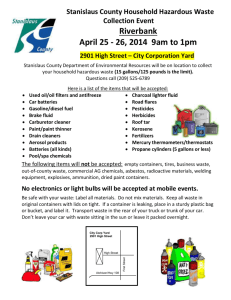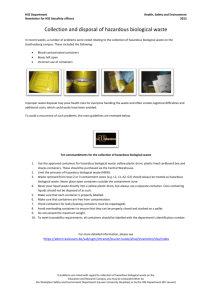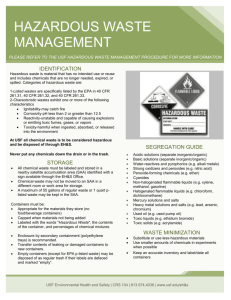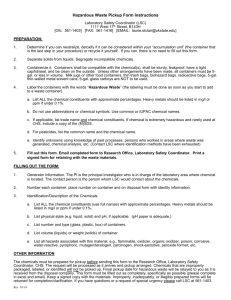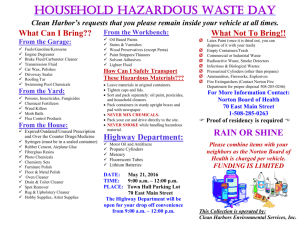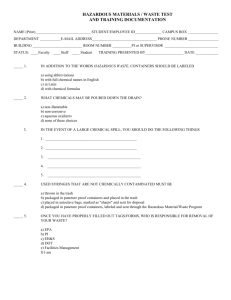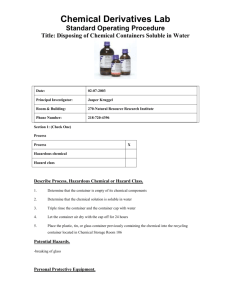UGA Best Management Practices: Used Oil
advertisement
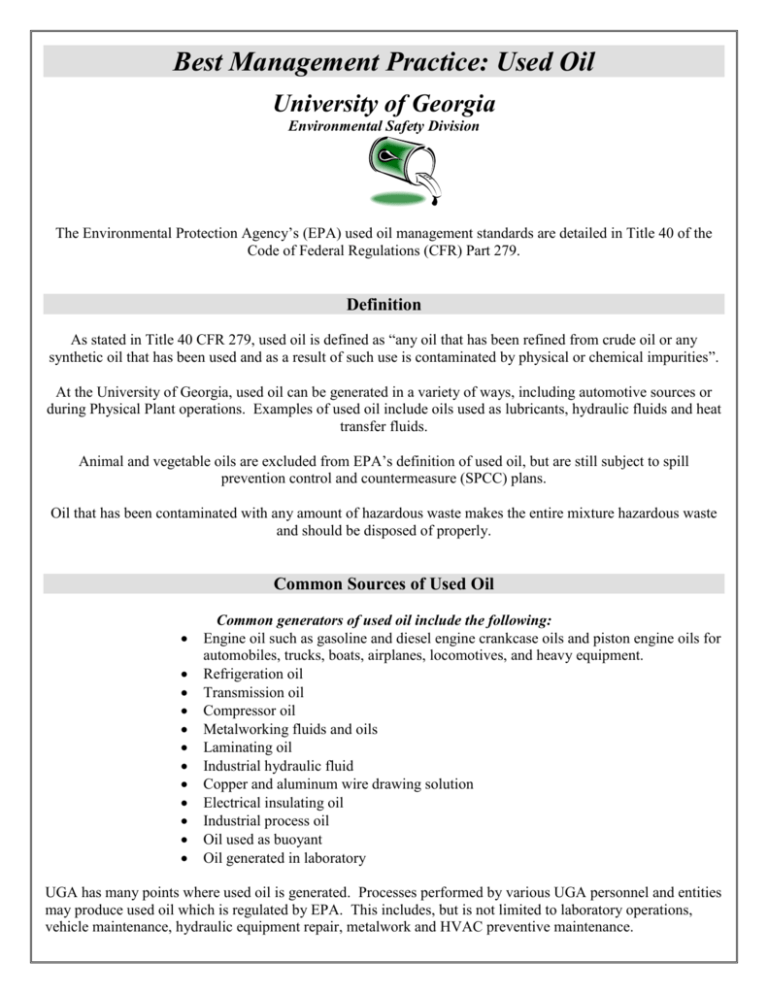
Best Management Practice: Used Oil University of Georgia Environmental Safety Division The Environmental Protection Agency’s (EPA) used oil management standards are detailed in Title 40 of the Code of Federal Regulations (CFR) Part 279. Definition As stated in Title 40 CFR 279, used oil is defined as “any oil that has been refined from crude oil or any synthetic oil that has been used and as a result of such use is contaminated by physical or chemical impurities”. At the University of Georgia, used oil can be generated in a variety of ways, including automotive sources or during Physical Plant operations. Examples of used oil include oils used as lubricants, hydraulic fluids and heat transfer fluids. Animal and vegetable oils are excluded from EPA’s definition of used oil, but are still subject to spill prevention control and countermeasure (SPCC) plans. Oil that has been contaminated with any amount of hazardous waste makes the entire mixture hazardous waste and should be disposed of properly. Common Sources of Used Oil Common generators of used oil include the following: Engine oil such as gasoline and diesel engine crankcase oils and piston engine oils for automobiles, trucks, boats, airplanes, locomotives, and heavy equipment. Refrigeration oil Transmission oil Compressor oil Metalworking fluids and oils Laminating oil Industrial hydraulic fluid Copper and aluminum wire drawing solution Electrical insulating oil Industrial process oil Oil used as buoyant Oil generated in laboratory UGA has many points where used oil is generated. Processes performed by various UGA personnel and entities may produce used oil which is regulated by EPA. This includes, but is not limited to laboratory operations, vehicle maintenance, hydraulic equipment repair, metalwork and HVAC preventive maintenance. Storage of Used Oil Please adhere to the following when storing used oil: Label containers, pipes, funnels & other apparatus used to direct used oil into storage reservoirs “Used Oil” Keep containers closed when not in use Inspect containers on a weekly basis and keep records to make sure containers are in good condition, no leaks, rust or deterioration When storing drums, keep an aisle space between drums to allow for inspection for leaks and damage Make sure used oil is in appropriately sized secondary containment. Containment should provide for 100% of the contents of the primary container should it fail Do not store used oil near water, floor drains or storm drains Make sure sorbent spill material is labeled and readily available Keep the storage area clean and orderly Do not mix oils and do not contaminate used oil with even small amounts of gasoline, brake cleaner, antifreeze, carburetor cleaner or other solvents Transport used oil in secondary containment Use appropriate sized funnels to help avoid spills Important tips on used oil storage and disposal: Never dump or dispose of used oil in the trash, sewer, storm drain or on the ground Comply with fire and safety regulations and provide maintenance on containers regularly to assure the storage container is leak and spill proof and are capped properly Managing and Disposing of Used Oil Filters Please adhere to the following when draining & disposing used oil filters: Drain filter of any remaining oil while it is still hot Gravity draining should be used after which the filters should be placed into a container capable of catching and holding any remaining used oil that may seep from filters The container should be protected from wet weather; inside the shop or in an appropriate shed or lean-to is acceptable Used oil filters must not be terne-plated. The lead in the terne plating makes the filters hazardous Transportation Transportation on Campus: Self-Transporting to Aggregation Points Generators may transport used oil they generate to an aggregation point if: A vehicle owned by the generator or an employee of the generator is used (such as a UGA vehicle); No more than 55 gallons is transported at one time in an acceptable, closed container that is in good condition; and The used oil is taken to an aggregation point owned by the same generator, for UGA this is at the Vehicle Transportation Maintenance facility (VTM) on Riverbend Road Self-transportation of used oil that has been mixed with hazardous waste is prohibited. Only authorized Environmental Safety Division hazardous waste facility personnel are permitted to transport hazardous waste. Proper labeling and DOT manifests are required. Call 706-369-5706 for more information. Transportation off Campus: Aggregation Point to Burner Facility The following regulations must be met when sending on-spec used oil for burning: Analyze the oil or obtain other information to prove it is not contaminated with hazardous materials and maintain the records for at least 3 years Use a permitted transporter with an EPA ID number; and Maintain for each shipment, for at least 3 years, records of: Name of facility burning oil Quantity of used oil delivered Date of shipment A reference to used oil analysis or other information used to determine that the used oil was free of haza Spills Upon detection of a used oil release: 1. Stop the release – close valves, use rags to plug punctures, upright fallen containers 2. Contain the released – use mats, “pigs” or other sorbent material to contain the spill 3. Clean up and manage the released oil properly – ensure that items used for cleaning show no signs of free flowing oil before disposing of them in regular trash; spilled used oil that has been cleaned up and not contaminated with hazardous waste is managed just as other used oil 4. Repair or replace any leaking and damaged containers prior to using again 5. For large spills, contact the UGA Hazard Assessment Response Team or the UGA police at 706-542-2200 Clean Up Materials Always have proper spill cleanup material clearly labeled, well stocked, and easily accessible. If a spill or leak occurs, stop the oil from flowing from the source of the leak. Use sorbent material to absorb the oil. Records Training: Employees must be educated and trained on the proper methods for handling used oil. Records of training (sign-in sheets, agendas, etc) must be kept onsite for a minimum of 3 years. Shipping Receipts: As stated under the Transportation category, shipping receipts must be kept for a minimum of 3 years. Inspections: Inspections of containers, pipes, etc. must be kept onsite for a minimum of 3 years.



